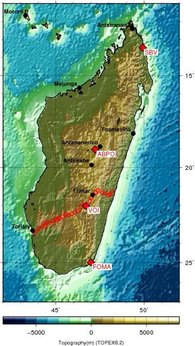Madagascar
Madagascar Seismic Profile
Time frame: 2012 - 2014
Summary
Madagascar is a complicated amalgamation of continental fragments, some of which are dating back to the Archaean. It was assembled during the formation of Gondwana at ~600 Ma and rifted from Africa at ~150 Ma. The last major tectonic episode experienced by Madagascar was the rifting from India at 90 Ma. The structural geology of southern Madagascar is dominated by the Ranotsara shear zone, an ancient structure possibly related to similar shear zones in Mozambique and southern India, which has later experienced a compressive event as recorded by folded structures and foliation of Southern Malagasy rocks. Weak ancient shear zones have also been hypothesized to act as conduits for magma causing the Neogene volcanism on Madagascar.
We have installed a linear array of 25 seismometers in the south of Madagascar and perpendicular to the main shearing direction of the Ranotsara shear zone to study the structure and the seismicity of southern Madagascar. The array also is at high angle to the transitions in crust and mantle lithospheric structure between the sedimentary basins in Western Madagascar and metamorphic and igneous rock in Eastern Madagascar.
Proposed analysis includes P and S receiver functions, surface wave dispersion measurements from regional earthquakes and ambient noise, shear wave splitting, local seismicity. It is also planned to incorporate the data into larger-scale tomographic inversions, e.g. with data from the RHUM-RUM experiment in the Indian ocean.
Contact:
Frederik Tilmann (GFZ Potsdam)
Xiaohui Yuan (GFZ Potsdam)
Collaborations
Georg Rümpker (University of Frankfurt)
Gérard Rambolamana (Université d'Antananarivo, Institut & Observatoire de Géophysique
d'Antananarivo)




